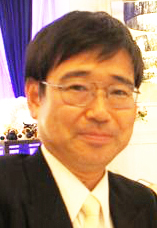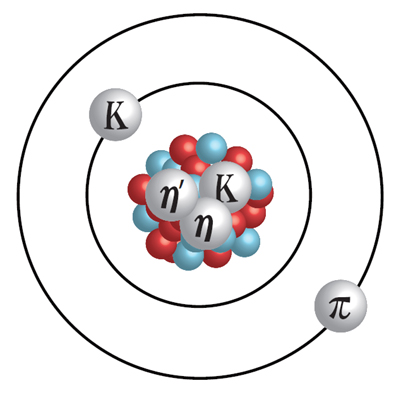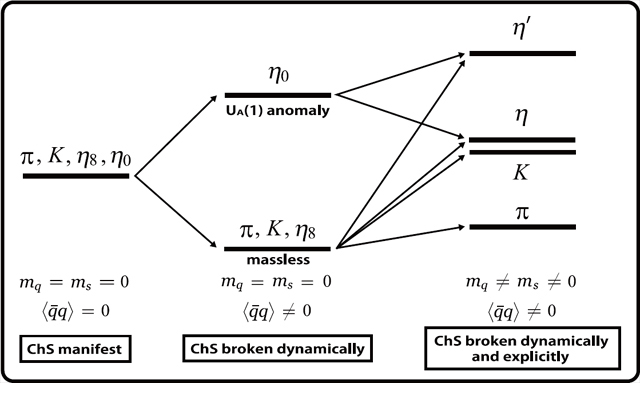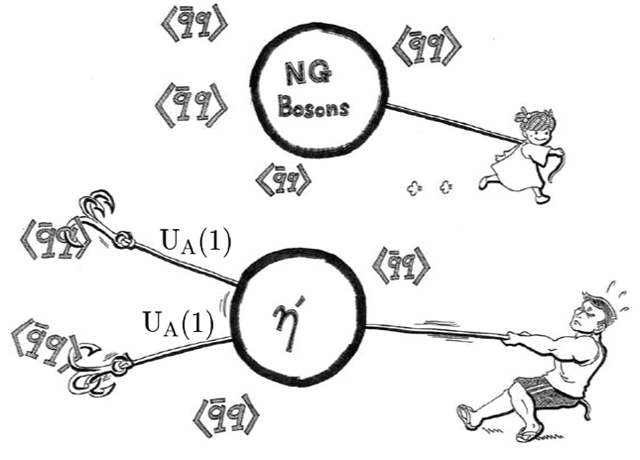Research on a "New Atom" Formed from Meson and Atomic Nucleus
 [Release: January, 2017]
[Release: January, 2017]
Professor Satoru Hirenzaki
Course of Physics
Department of Mathematical and Physical Sciences
Faculty of Science
Nara Women's University
Four fundamental forces exist in nature. The tiny particle which feels strong interaction is known as the hadron. Through a new hadron many-body system (an aggregate), we are making progress in our research on a "world" of strong interactions. We focus particularly on a "new atom" that is different from typical atoms (Reference 1).
•Discontinuities in the layered structure of matter, and the world controlled by the strong force
The subject of our research is a world where various phenomena occur owing to strong force. First, in order to understand where this world is located, I will explain the layered structure of matter that surrounds us and the "discontinuities" that exist between these layers. In science classes, we learn that the matter around us is composed of molecules and atoms. However, atoms themselves are not the smallest units of matter. There are particles that are smaller than atoms and that make up atoms, and therefore make up matter. In descending order of size: molecules > atoms > atomic nuclei > protons and neutrons > quarks. Protons and neutrons are types of hadron, and are held together by the strong nuclear force. Within this layered structure, a large discontinuity exists between the group composed of "molecules and atoms" and the group composed of "atomic nuclei, protons and neutrons, and quarks." At the discontinuity, the size of particles and the strength of the force that operates between particles suddenly change by a factor between 10,000 and 100,000. If we consider, for instance, that the difference between the speed of a pedestrian and that of a jet plane is given by at most a factor of 200, then we can imagine that a factor of 100,000 represents an exceedingly large difference. The most important force operating at the atomic and molecular levels is the electromagnetic force. This force, along with gravity, controls most of the phenomena occurring in nature that we witness around us. However, in the world of particles even smaller than the atomic nucleus, the strong force, which is the most powerful force, controls a variety of phenomena. This world of strong force is hardly affected by the "world of electromagnetic force" that we live in. That is, there is another world that we do not perceive in our everyday lifeóthe world of the strong forceóthat exists simultaneously with the world we perceive around us. Our research deals with this world of strong force.
•What is a mesonic atom? What can we learn from it?
In the normal atoms that exist around us, electrons orbit around the atomic nucleus. An electron is a kind of particle, called a lepton, that does not feel strong force. The electromagnetic force is important in the formation of normal atoms. The atomic nucleus at the center of an atom is an aggregation of hadrons, specifically of protons and neutrons. However, by attaching mesons, which are another kind of hadron, it is possible to form a "new atom" composed exclusively of hadrons. That is, if the electrons of a normal atom are replaced by mesons, then a new "mesonic atom" is formed. Figure 1 shows a diagram of a hadron aggregate in which various mesons are attached to an atomic nucleus. The pi meson, or pion, originally proposed by Dr. Hideki Yukawa, is a typical hadron. The negatively charged pion forms a pionic atom when it is bound around the nucleus by the combined effects exerted on it by the strong force and the electromagnetic force. This pionic atom plays an important role as a new "window" through which we can view strong interactions, as I will explain next (References 2 and 3).
There are two important and interesting points that I would like to make concerning this. The first point is one that provides the basis for research into the properties of matter bound by the strong force. All of the natural phenomena occurring around us that are based on chemical changes are produced, as stated above, by the electromagnetic force. The strong force, however, is understood to have more complex properties than the electromagnetic force. It is possible that matter composed of aggregated hadrons may form a more complex world than the world that surrounds us. If we consider that the activities of all life forms that we are familiar with, including humans, are results of "gifts of electromagnetism," then "life composed of clumps of hadrons" arising in a world controlled by the strong force may also be similarly active (see note). Research into objects that are composed only of hadrons, such as mesonic atoms, forms the foundation on the basis of which such possibilities may be investigated.
The next important point is that it may be possible to investigate the relationship between the "world of quarks" and the "world of hadrons" by causing mesons to enter into the nucleus. There may be mysterious transitions occurring between these two worlds that differ from the discontinuities between the layers described above. For example, in laymanís terms, it is thought that the origin of the mass of the matter that surrounds us may be related to such transitions. Almost all of the mass of the matter around us, including our own bodies, is composed of masses of atomic nuclei. The mass of a nucleus is almost equivalent to the sum of the masses of the protons and neutrons that constitute it. However, owing to the famous Higgs mechanism, the total mass of the quarks that make up the nucleus is much smaller than the mass of the nucleus itself. The sum of the masses of these quarks is less than 5% of the total mass of the protons and neutrons that form the nucleus. It is thought that the remaining 95% is produced when loose quarks attach to each other to form hadrons. By what mechanism does this occur? To understand this, various kinds of experiments are being conducted in which hadrons are brought together and condensed to produce situations in which the activity of the quarks that make up the hadrons can be easily observed. Mesonic atoms represent one of these important situations. In other words, we send mesons into the nucleus and then investigate the resulting situation. Figure 2 is a conceptual diagram of the mechanism by which mesons are currently thought to acquire mass.

Figure 1. Diagram of a new hadron aggregate formed by attaching various mesons to the nucleus (from Reference 1). An atom in which mesons, instead of electrons, surround the nucleus is called a "mesonic atom." When a meson has almost entered the interior of a nucleus, the nucleus is called a "mesonic nucleus."

Figure 2. A conceptual diagram of the mechanism by which the hadron known as the pseudo-scalar meson is currently believed to acquire mass, as has been observed in experiments.
(Source: From D. Jido, S. Sakai, H. Nagahiro, S. Hirenzaki, N. Ikeno, Proceedings of 11th International Conference on Hypernuclear and Strange Particle Physics (HYP2012), Nuclear Physics A914, pp. 354ĀE59, (2013), H. Nagahiro, D. Jido, H. Fujioka, K. Itahashi, S. Hirenzaki, Phys. Rev. C 87, 045201 (2013).)
•Most Recent Research and Future Developments
Although the existence of pion has been known for some time, the field of research introduced in the previous section has been recently expanded through our successful production and observation of the "deeply bound pionic atom" for the first time in the world (References 2 and 3). Currently, aside from the pionic atom, research is also progressing on inserting kaons, η mesons, η' mesons, and f mesons into the nucleus. In particular, the mechanism by which η' mesons acquire exceptionally large mass has stimulated a lot of recent international interest (Figure 3, Reference 4). In addition, as each type of meson has individual characteristics, it is possible to study various aspects of the world of the strong force using different types of meson. We expect to see fascinating developments emerge from this field, in which theoretical and experimental research methods are stimulating each other while also cooperating closely, resulting in important advancements.

Figure 3. Diagram of the mechanism by which the masses of η' mesons become exceptionally large in pseudo-scalar mesons (from Reference 1).
Note: This idea has previously appeared in science fiction, notably in Robert L. Forward's "Dragon's Egg." (The Japanese version is available from Hayakawa Publishing). It is a very interesting read.
References
1. "Physics of Meson-Nucleus Bound Systems - The Strong Side of the World,"
Hirenzaki Satoru, Frontiers in Physics, Kyouritsu Shuppan Co. Ltd. (published in 2017).
http://www.kyoritsu-pub.co.jp/bookdetail/9784320035355
(A reference book recommended for those with a basic knowledge of physics at the college level.)
2. "Deeply bound Pionic States in Heavy Nuclei,"
T. Yamazaki, S. Hirenzaki, R. S. Hayano, H. Toki, Phys. Report 514, 1 (2012).
http://www.sciencedirect.com/science/article/pii/S0370157312000129
(A comprehensive report on research on pionic atoms. Accessible to graduate school students and experts.)
3. "Precision Spectroscopy of Pionic 1s States of Sn Nuclei and Evidence for Partial Restoration of Chiral Symmetry in the Nuclear Medium,"
K. Suzuki et al., Phys. Rev. Lett. 92, 072302 (2004).
http://journals.aps.org/prl/abstract/10.1103/PhysRevLett.92.072302
(One of the most important original papers on the observation of deeply bound pionic atoms. Accessible to graduate school students and experts.)
4. "Measurement of Excitation Spectra in 12C(p,d) Reaction Near the Eta-prime Emission Threshold,"
Y. K. Tanaka et al., Phys. Rev. Lett. 117, 202501 (2016).
http://journals.aps.org/prl/abstract/10.1103/PhysRevLett.117.202501
(An original paper that reports on the first experiment in the world to observe η' mesonic nuclei. At the time of writing, this is an example of cutting-edge research. Accessible to graduate school students and experts.)

